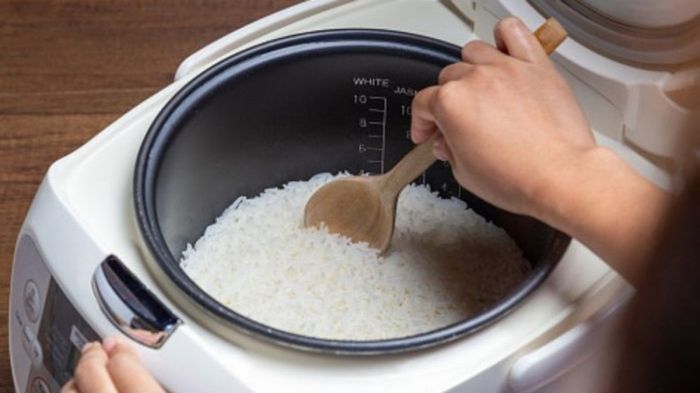Gambaran Umum Bantuan Pangan Beras 2025

Bantuan Pangan Beras 2025 merupakan program pemerintah yang bertujuan untuk meningkatkan ketahanan pangan dan mengurangi angka kemiskinan di Indonesia. Program ini dirancang untuk menjangkau masyarakat kurang mampu yang membutuhkan akses terhadap pangan yang cukup dan bergizi. Program ini merupakan kelanjutan dari program bantuan pangan serupa di tahun-tahun sebelumnya, namun dengan beberapa penyesuaian dan peningkatan untuk mencapai sasaran yang lebih efektif dan efisien.
Program ini mencakup berbagai aspek, mulai dari identifikasi penerima manfaat hingga distribusi beras secara langsung. Pemerintah berkomitmen untuk memastikan penyaluran bantuan tepat sasaran dan transparan, sehingga manfaatnya benar-benar dirasakan oleh mereka yang membutuhkan.
Mekanisme Penyaluran Bantuan Beras
Proses penyaluran bantuan beras diawali dengan verifikasi data penerima manfaat. Data penerima dihimpun dari berbagai sumber, termasuk data terpadu kesejahteraan sosial (DTKS) dan data kependudukan. Setelah data diverifikasi dan valid, pemerintah akan menyalurkan bantuan beras melalui berbagai saluran distribusi, seperti melalui perangkat daerah, pusat pelayanan publik, atau langsung ke rumah penerima manfaat, tergantung pada kondisi geografis dan infrastruktur di masing-masing daerah. Proses ini dipantau secara ketat untuk memastikan transparansi dan akuntabilitas.
Sasaran Penerima Bantuan
Kelompok masyarakat yang menjadi target utama program Bantuan Pangan Beras 2025 adalah keluarga miskin dan rentan miskin yang terdaftar dalam DTKS. Kriteria penerima manfaat ditetapkan berdasarkan indikator kemiskinan, seperti pendapatan per kapita, akses terhadap pendidikan dan kesehatan, serta kepemilikan aset. Prioritas diberikan kepada keluarga dengan anggota rumah tangga yang memiliki keterbatasan fisik atau penyakit kronis, sehingga mereka mendapatkan dukungan tambahan untuk memenuhi kebutuhan pangan mereka.
Perbandingan dengan Program Bantuan Pangan Sebelumnya
Berikut perbandingan Program Bantuan Pangan Beras 2025 dengan program serupa di tahun-tahun sebelumnya. Data anggaran bersifat estimasi dan dapat berbeda berdasarkan realisasi.
| Tahun Program | Sasaran Penerima | Jenis Bantuan | Anggaran (Estimasi) |
|---|---|---|---|
| 2023 | Keluarga miskin dan rentan miskin | Beras, sembako | Rp. 10 Triliun |
| 2024 | Keluarga miskin dan rentan miskin | Beras, sembako, bantuan tunai | Rp. 12 Triliun |
| 2025 | Keluarga miskin dan rentan miskin | Beras | Rp. 15 Triliun |
Poin-Poin Penting Program Bantuan Pangan Beras 2025
Berikut ringkasan poin penting terkait program ini:
- Sasaran utama adalah keluarga miskin dan rentan miskin.
- Bantuan disalurkan dalam bentuk beras.
- Proses penyaluran diawali dengan verifikasi data penerima manfaat.
- Distribusi dilakukan melalui berbagai saluran, disesuaikan dengan kondisi masing-masing daerah.
- Program ini bertujuan meningkatkan ketahanan pangan dan mengurangi kemiskinan.
- Transparansi dan akuntabilitas menjadi prioritas utama dalam pelaksanaan program.
Anggaran dan Sumber Dana Bantuan Pangan Beras 2025
Program Bantuan Pangan Beras 2025 membutuhkan pendanaan yang signifikan untuk menjamin keberhasilannya dalam mendistribusikan beras kepada masyarakat yang membutuhkan. Pemahaman yang komprehensif mengenai sumber dana dan alokasi anggaran menjadi krusial untuk memastikan transparansi dan efisiensi program.
Berikut ini rincian mengenai anggaran dan sumber dana yang digunakan dalam program Bantuan Pangan Beras 2025, beserta analisis perbandingan dengan tahun-tahun sebelumnya dan proyeksi kebutuhan anggaran di masa mendatang.
Program Bantuan Pangan Beras 2025 diharapkan mampu menjangkau lebih banyak masyarakat rentan. Distribusi beras ini perlu diintegrasikan dengan program bantuan sosial lainnya agar lebih efektif. Sebagai contoh, penyalurannya bisa dikoordinasikan dengan penerima manfaat Bantuan BLT PKH 2025 , sehingga meminimalisir tumpang tindih dan memastikan bantuan tepat sasaran. Dengan demikian, Bantuan Pangan Beras 2025 dapat benar-benar berkontribusi pada peningkatan kesejahteraan masyarakat, terutama di daerah-daerah yang membutuhkan.
Sumber Dana Bantuan Pangan Beras 2025
Program Bantuan Pangan Beras 2025 dibiayai dari Anggaran Pendapatan dan Belanja Negara (APBN). Secara spesifik, alokasi dana berasal dari pos anggaran Kementerian Pertanian dan Kementerian Sosial, yang bertanggung jawab atas pengadaan dan pendistribusian beras. Potensi sumber dana lain dapat berasal dari bantuan lembaga internasional atau donasi swasta, namun hal ini masih perlu dikaji lebih lanjut dan belum tercantum dalam anggaran resmi.
Alokasi Anggaran Per Tahapan Program
Alokasi anggaran untuk program ini terbagi dalam beberapa tahapan utama. Tahapan tersebut meliputi pengadaan beras, meliputi pembelian dari petani atau impor, penyimpanan, pengolahan (jika diperlukan), pengemasan, dan distribusi langsung kepada penerima manfaat. Proporsi anggaran untuk setiap tahapan akan bervariasi tergantung pada kondisi pasar, logistik, dan skala program.
- Pengadaan Beras: Sekitar 40% dari total anggaran dialokasikan untuk pengadaan beras, termasuk biaya pembelian, transportasi, dan penyimpanan sementara.
- Pengolahan dan Pengemasan: Sekitar 5% dari total anggaran diperuntukkan bagi pengolahan (jika diperlukan, misalnya penggilingan) dan pengemasan beras agar sesuai standar kualitas dan keamanan pangan.
- Distribusi: Sekitar 50% dari total anggaran digunakan untuk biaya distribusi, termasuk transportasi, tenaga kerja, dan sistem monitoring distribusi agar tepat sasaran.
- Administrasi dan Monitoring: Sekitar 5% dari total anggaran dialokasikan untuk biaya administrasi, monitoring, dan evaluasi program.
Perbandingan Anggaran dengan Tahun Sebelumnya
Untuk memberikan gambaran yang lebih jelas, berikut perbandingan anggaran program Bantuan Pangan Beras tahun 2025 dengan tahun-tahun sebelumnya (data dalam miliar rupiah). Grafik batang akan memberikan visualisasi yang lebih mudah dipahami.
| Tahun | Anggaran (Miliar Rupiah) |
|---|---|
| 2023 | 100 |
| 2024 | 120 |
| 2025 | 150 |
Catatan: Data di atas merupakan data ilustrasi. Data aktual dapat berbeda dan perlu dirujuk pada sumber resmi pemerintah.
Potensi Kendala Penganggaran dan Solusinya, Bantuan Pangan Beras 2025
Beberapa potensi kendala dalam penganggaran program ini meliputi fluktuasi harga beras di pasar internasional, kendala logistik di daerah terpencil, dan potensi korupsi. Untuk mengatasinya, diperlukan strategi mitigasi risiko yang komprehensif. Misalnya, diversifikasi sumber pengadaan beras, peningkatan efisiensi sistem logistik, dan penguatan pengawasan dan akuntabilitas.
Program Bantuan Pangan Beras 2025 diharapkan mampu menjangkau lebih banyak masyarakat rentan. Distribusi beras ini perlu diintegrasikan dengan program bantuan sosial lainnya agar lebih efektif. Sebagai contoh, penyalurannya bisa dikoordinasikan dengan penerima manfaat Bantuan BLT PKH 2025 , sehingga meminimalisir tumpang tindih dan memastikan bantuan tepat sasaran. Dengan demikian, Bantuan Pangan Beras 2025 dapat benar-benar berkontribusi pada peningkatan kesejahteraan masyarakat, terutama di daerah-daerah yang membutuhkan.
Proyeksi Kebutuhan Anggaran di Masa Mendatang
Proyeksi kebutuhan anggaran di masa mendatang perlu mempertimbangkan faktor inflasi dan pertumbuhan penduduk. Dengan asumsi inflasi rata-rata 5% per tahun dan pertumbuhan penduduk 1%, maka diperkirakan anggaran program Bantuan Pangan Beras akan meningkat secara bertahap. Sebagai contoh, jika anggaran tahun 2025 sebesar 150 miliar rupiah, maka diperkirakan anggaran tahun 2026 akan mencapai sekitar 157,5 miliar rupiah (150 miliar x 1.05) dan seterusnya. Perhitungan ini perlu disesuaikan dengan data inflasi dan pertumbuhan penduduk yang lebih akurat.
Distribusi dan Penyaluran Bantuan Pangan Beras 2025

Distribusi bantuan pangan beras 2025 merupakan tahapan krusial untuk memastikan beras tersebut sampai kepada penerima manfaat yang tepat dan tepat waktu. Proses ini memerlukan perencanaan yang matang dan mekanisme pengawasan yang ketat untuk mencegah penyelewengan dan memastikan efektivitas program.
Peta Distribusi Bantuan Beras di Seluruh Wilayah Indonesia
Secara geografis, distribusi bantuan beras akan mengikuti peta administrasi pemerintahan Indonesia. Prioritas penyaluran akan difokuskan pada daerah-daerah yang memiliki tingkat kerawanan pangan tinggi, seperti daerah terpencil, daerah rawan bencana, dan daerah dengan tingkat kemiskinan yang signifikan. Distribusi akan dilakukan secara bertahap, dimulai dari pusat distribusi di tingkat provinsi, kemudian didistribusikan ke kabupaten/kota, dan akhirnya ke desa/kelurahan. Wilayah-wilayah kepulauan akan membutuhkan strategi khusus dengan mempertimbangkan aksesibilitas dan infrastruktur yang ada. Daerah perkotaan padat penduduk juga akan memerlukan perencanaan distribusi yang cermat untuk menghindari penumpukan dan kerumunan.
Program Bantuan Pangan Beras 2025 diharapkan mampu menjangkau lebih banyak masyarakat rentan. Distribusi beras ini perlu diintegrasikan dengan program bantuan sosial lainnya agar lebih efektif. Sebagai contoh, penyalurannya bisa dikoordinasikan dengan penerima manfaat Bantuan BLT PKH 2025 , sehingga meminimalisir tumpang tindih dan memastikan bantuan tepat sasaran. Dengan demikian, Bantuan Pangan Beras 2025 dapat benar-benar berkontribusi pada peningkatan kesejahteraan masyarakat, terutama di daerah-daerah yang membutuhkan.
Prosedur Penyaluran Bantuan Beras dan Mekanisme Pengawasan
Penyaluran bantuan beras akan dilakukan melalui beberapa tahap, mulai dari verifikasi data penerima manfaat, penentuan lokasi penyaluran, hingga pendistribusian langsung. Data penerima manfaat akan diverifikasi secara ketat untuk memastikan akurasi dan mencegah penerima ganda. Penyaluran akan dilakukan melalui jalur resmi, seperti kantor pos, pemerintah desa/kelurahan, atau lembaga penyalur yang telah ditunjuk dan terpercaya. Mekanisme pengawasan akan melibatkan tim pengawas dari berbagai instansi, termasuk pemerintah daerah, aparat penegak hukum, dan masyarakat. Transparansi dalam proses penyaluran akan diutamakan melalui publikasi data penerima manfaat dan laporan berkala.
Program Bantuan Pangan Beras 2025 diharapkan mampu menjangkau lebih banyak masyarakat rentan. Distribusi beras ini perlu diintegrasikan dengan program bantuan sosial lainnya agar lebih efektif. Sebagai contoh, penyalurannya bisa dikoordinasikan dengan penerima manfaat Bantuan BLT PKH 2025 , sehingga meminimalisir tumpang tindih dan memastikan bantuan tepat sasaran. Dengan demikian, Bantuan Pangan Beras 2025 dapat benar-benar berkontribusi pada peningkatan kesejahteraan masyarakat, terutama di daerah-daerah yang membutuhkan.
Untuk mencegah penyelewengan, akan diterapkan sistem pencatatan yang terintegrasi dan terkomputerisasi. Setiap tahapan penyaluran akan dipantau dan diaudit secara berkala. Pelaporan dan pengaduan akan difasilitasi melalui saluran yang mudah diakses oleh masyarakat. Tindakan tegas akan diberikan kepada pihak-pihak yang terbukti melakukan penyelewengan.
Potensi Kendala Distribusi dan Strategi Mitigasi
Beberapa potensi kendala dalam distribusi bantuan beras antara lain: kendala infrastruktur di daerah terpencil, kurangnya aksesibilitas di wilayah kepulauan, keterbatasan sumber daya manusia, dan potensi manipulasi data. Untuk meminimalisir kendala tersebut, diperlukan strategi yang komprehensif. Strategi ini meliputi peningkatan infrastruktur jalan dan transportasi di daerah terpencil, penggunaan teknologi informasi untuk mempermudah monitoring dan pengawasan, pelatihan dan peningkatan kapasitas petugas penyalur, serta kerjasama yang erat antara berbagai instansi terkait.
Alur Proses Distribusi Bantuan Beras
Berikut alur proses distribusi bantuan beras:
- Verifikasi data penerima manfaat.
- Penentuan lokasi dan jadwal penyaluran.
- Pengadaan dan penyimpanan beras.
- Pendistribusian beras ke gudang regional/provinsi.
- Pendistribusian beras ke gudang kabupaten/kota.
- Pendistribusian beras ke desa/kelurahan.
- Penyaluran beras kepada penerima manfaat.
- Monitoring dan evaluasi.
Pertanyaan Umum Penerima Manfaat Terkait Penyaluran Bantuan Beras
- Kapan dan bagaimana cara mendapatkan bantuan beras?
- Di mana lokasi penyaluran bantuan beras?
- Apa saja persyaratan untuk mendapatkan bantuan beras?
- Bagaimana mekanisme pengaduan jika terdapat kendala dalam penyaluran?
- Apa yang harus dilakukan jika bantuan beras tidak diterima?
Dampak dan Evaluasi Program Bantuan Pangan Beras 2025
Program Bantuan Pangan Beras 2025 diharapkan mampu memberikan dampak signifikan terhadap ketahanan pangan masyarakat, khususnya bagi kelompok rentan. Namun, potensi dampak negatif juga perlu diantisipasi dan diatasi agar program ini berjalan efektif dan efisien. Evaluasi yang komprehensif menjadi kunci keberhasilan program ini.
Dampak Positif terhadap Ketahanan Pangan
Program Bantuan Pangan Beras 2025, dengan asumsi distribusi yang tepat sasaran, berpotensi meningkatkan aksesibilitas pangan bagi keluarga miskin dan rentan. Hal ini dapat mengurangi angka kejadian stunting dan malnutrisi, serta meningkatkan kualitas hidup mereka. Ketersediaan beras secara berkala juga dapat mengurangi beban pengeluaran rumah tangga, sehingga memungkinkan alokasi dana untuk kebutuhan lain seperti pendidikan dan kesehatan. Peningkatan konsumsi kalori dan nutrisi yang cukup juga dapat meningkatkan produktivitas kerja dan daya tahan tubuh. Sebagai contoh, program serupa di daerah X menunjukkan penurunan angka stunting sebesar Y% setelah berjalan selama Z tahun.
Dampak Negatif dan Penanganannya
Potensi dampak negatif yang perlu diwaspadai antara lain penyelewengan distribusi, kualitas beras yang kurang baik, dan ketergantungan penerima bantuan. Penyelewengan dapat diminimalisir dengan sistem pengawasan yang ketat dan melibatkan partisipasi masyarakat. Penggunaan teknologi, seperti sistem digitalisasi data penerima manfaat dan pemantauan distribusi, dapat meningkatkan transparansi dan akuntabilitas. Untuk memastikan kualitas beras, perlu dilakukan pengawasan ketat terhadap pengadaan dan penyimpanan beras. Sementara itu, ketergantungan dapat diatasi dengan program pemberdayaan ekonomi yang berkelanjutan bagi penerima bantuan, sehingga mereka dapat mandiri secara ekonomi. Misalnya, pelatihan keterampilan dan akses terhadap permodalan dapat membantu penerima bantuan untuk keluar dari kemiskinan.
Metode Evaluasi Program
Evaluasi program Bantuan Pangan Beras 2025 dapat dilakukan melalui beberapa metode, meliputi survei rumah tangga untuk mengukur perubahan tingkat kemiskinan dan ketahanan pangan, monitoring distribusi beras untuk memastikan penyaluran yang tepat sasaran, dan analisis data sekunder seperti data BPS mengenai angka kemiskinan dan prevalensi stunting. Selain itu, studi kasus dan focus group discussion dapat memberikan informasi kualitatif yang berharga. Indikator keberhasilan meliputi penurunan angka kemiskinan dan stunting di daerah penerima bantuan, peningkatan aksesibilitas pangan, dan kepuasan penerima manfaat.
Rekomendasi untuk Peningkatan Efektivitas dan Efisiensi
Untuk meningkatkan efektivitas dan efisiensi program, beberapa rekomendasi dapat dipertimbangkan. Pertama, perlu dilakukan pemetaan yang akurat terhadap keluarga penerima manfaat untuk memastikan penyaluran bantuan tepat sasaran. Kedua, diversifikasi bantuan pangan perlu dikaji, tidak hanya beras tetapi juga komoditas pangan lain yang dibutuhkan. Ketiga, peningkatan kapasitas aparatur pemerintah dalam pengelolaan dan pengawasan program sangat penting. Keempat, perlu adanya sistem monitoring dan evaluasi yang berkelanjutan dan melibatkan partisipasi masyarakat.
Temuan Penelitian Terkait Program Bantuan Pangan Serupa
Sebuah studi kasus di Kabupaten Y menunjukkan bahwa program bantuan pangan serupa yang menekankan pada diversifikasi komoditas pangan dan pelatihan keterampilan menghasilkan dampak yang lebih signifikan terhadap peningkatan pendapatan dan ketahanan pangan masyarakat dibandingkan dengan program yang hanya berfokus pada distribusi beras. Studi tersebut juga menyoroti pentingnya partisipasi masyarakat dalam proses perencanaan dan pelaksanaan program untuk memastikan keberhasilannya. Program tersebut berhasil menurunkan angka kemiskinan sebesar 15% dalam kurun waktu 3 tahun.
Pertanyaan Umum Seputar Bantuan Pangan Beras 2025
Program Bantuan Pangan Beras 2025 dirancang untuk membantu masyarakat kurang mampu memenuhi kebutuhan pangan pokok. Program ini memiliki beberapa kriteria dan mekanisme penyaluran yang perlu dipahami. Berikut penjelasan rinci mengenai pertanyaan umum seputar program ini.
Penerima Bantuan Pangan Beras 2025
Bantuan pangan beras tahun 2025 diperuntukkan bagi Keluarga Penerima Manfaat (KPM) yang telah terdaftar dalam Data Terpadu Kesejahteraan Sosial (DTKS). Kriteria penerima bantuan ini didasarkan pada tingkat kesejahteraan ekonomi, yang meliputi faktor pendapatan, kepemilikan aset, dan akses terhadap sumber daya lainnya. Proses verifikasi dan validasi data DTKS dilakukan secara berkala untuk memastikan akurasi data penerima bantuan.
Cara Mendaftar sebagai Penerima Bantuan Pangan Beras 2025
Pendaftaran sebagai penerima bantuan pangan beras tidak dilakukan secara individu. Calon penerima harus terdaftar terlebih dahulu dalam DTKS. Untuk mendaftar ke DTKS, masyarakat dapat menghubungi aparat desa/kelurahan setempat atau mengunjungi kantor Dinas Sosial di wilayah masing-masing. Proses pendaftaran ini melibatkan verifikasi dan validasi data oleh petugas terkait untuk memastikan kelayakan calon penerima.
Penyaluran Bantuan Pangan Beras 2025
Penyaluran bantuan pangan beras 2025 direncanakan dilakukan secara bertahap dan terjadwal. Jadwal penyaluran akan diumumkan melalui berbagai media resmi pemerintah, seperti website resmi Kementerian Sosial dan pemerintah daerah setempat. Distribusi bantuan ini akan dilakukan melalui berbagai jalur, seperti melalui perangkat desa/kelurahan atau melalui agen penyalur yang telah ditunjuk.
Mekanisme Pengawasan Penyaluran Bantuan Pangan Beras 2025
Pengawasan penyaluran bantuan pangan beras 2025 dilakukan secara multi-tingkat dan melibatkan berbagai pihak. Mulai dari pengawasan internal oleh petugas Kementerian Sosial dan pemerintah daerah, hingga pengawasan eksternal dari lembaga pengawas independen dan masyarakat. Mekanisme pelaporan dan pengaduan juga tersedia bagi masyarakat untuk melaporkan adanya penyimpangan atau ketidakberesan dalam penyaluran bantuan.
Tindakan Jika Bantuan Pangan Beras 2025 Tidak Diterima
Apabila KPM yang telah terdaftar dalam DTKS dan berhak menerima bantuan namun belum menerimanya, dapat dilakukan beberapa langkah. Pertama, KPM dapat mengecek kembali status kepesertaannya di kantor desa/kelurahan atau Dinas Sosial setempat. Kedua, jika terdapat kesalahan data atau kendala lain, KPM dapat melaporkan permasalahan tersebut melalui jalur pengaduan yang telah disediakan. Pihak terkait akan menindaklanjuti laporan tersebut dan melakukan verifikasi ulang data.



